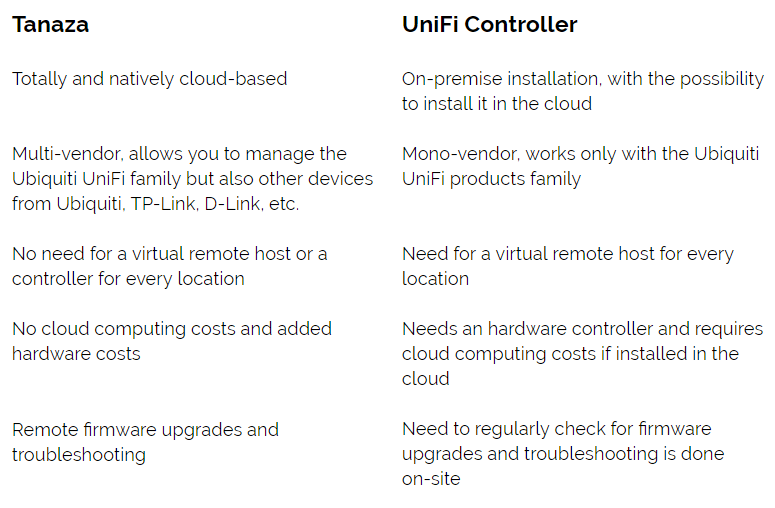A network management software is a program that discovers, provisions, monitors and maintains computer networks.
Computer Networks can be very complex but, thanks to a network management software, this complexity becomes manageable.
What are the differences between unlicensed and licensed spectrum? And what is the relation between unlicensed spectrum WIFI and the benefits Wi-Fi brings to society? Let’s answer these answers below.

The term spectrum wifi refers to all the radio frequencies, from 3 kHz to 300 GHz, available for wireless communications. There are two types of radio spectrum established by the Federal Communication Commission: licensed and unlicensed. Licensed spectrum consists of frequencies made available to companies for a specific use, i.e. cellular companies connecting people through wireless phone services that work transmitting data over the air. Spectrum licenses provided by the FCC are always needed for mobile operators, i.e. Verizon and AT&T, and establish conditions such as fees and charges and other parameters such as the frequency band – in general between 700 MHz and 2.6 GHz – and network coverage they can use: indeed, mobile carriers providing 3G and 4G mobile services can’t operate on the same band at the same time and with the same geographical reach. In this respect, the FCC regularly checks on its spectrum dashboard “how spectrum bands are allocated and for what uses, and who holds licenses and in what areas”.
On the other hand, unlicensed spectrum wifi is publicly owned, has light rules to follow and is free, meaning no paid license is needed for those who want to use it. Wi-Fi is the most popular technology taking advantage of the affordable unlicensed spectrum in order to deliver high-performing connectivity, and it can carry more data traffic than other wireless solutions. For this reason, unlicensed spectrum is an extremely valuable benefit for people, who more and more rely on Wi-Fi as the main resource for accessing the internet. Let’s see the main advantages unlicensed spectrum brings to technologies such as Wi-Fi and, consequently, to society as a whole:
Unlicensed spectrum wifi is a highly valuable resource, which can be smartly leveraged by wireless technologies such as Wi-Fi in order to boost innovation and find effective ways to bring improvements to the whole society.
https://www.classichotspot.com/blog/the-benefits-of-public-wi-fi-access-on-our-society/
https://www.classichotspot.com/blog/4-reasons-5g-cellular-wont-threat-wi-fi/

Let’s find out in this post the main 4 Wi-Fi cloud-based services MSPs should provide SMEs with, in order to add value to their offering.
Nowadays, more and more small and medium-sized companies rely on cloud-based services to grow their Wi-Fi businesses and improve their productivity. According to the Worldwide Semiannual Public Cloud Services Spending Guide from International Data Corporation (IDC), the overall spending on public cloud services will grow from $70 billion in 2015 to $141 billion in 2019 at the worldwide level. Specifically, from a company size point of view, SMBs counting less than 500 employees will count for more than 40% of the total expenditure. Accordingly, MSPs should leverage cloud computing to offer valuable cloud-based services to their customers.
In parallel to the overall growth of the cloud computing market, we’ve seen that an increasing number of manufacturers and software companies in the Wi-Fi space has started delivering cloud-based services to manage and monitor Wi-Fi networks, replacing hardware controllers with virtual cloud-based network controllers.
Here is a list of 4 much-sought Wi-Fi cloud-based services in the small and midsize markets, which MSPs should offer to add value to their services.
Small and medium-sized companies can gain greater flexibility from managing their Wi-Fi networks on the cloud, as they can run their businesses from anywhere, anytime. Furthermore, thanks to remote management enterprises do not have to take total control over the infrastructure anymore, which allows them to dedicate more time to other activities. Accordingly, you should provide a serviceable to make things easier both for you and your customers: the Wi-Fi cloud-based management offered by Tanaza, for instance, ensures 100% remote deployment, configuration, firmware upgrade, and troubleshooting. In this way, you won’t have to go on-site to reboot a broken access point, and you will be able to configure all aspects of your clients’ networks directly from the Tanaza Cloud Dashboard: this will save a lot of time for both of you!
Cloud-based monitoring is a very useful service to offer, as it allows companies to save time and easily monitor their deployments located in one or more places worldwide. MSPs can rely on Tanaza, the easy-to-use, and affordable cloud-based software for remotely monitoring small or large networks of access points, in real-time. Furthermore, it gives the possibility to set up customizable instant alerts, i.e. through emails or SMS, if the system is experiencing issues, such as capacity overloads or faults.
The possibility for companies to filter web content based on their business needs is a must-have service. Through a cloud-based filtering solution, network administrators can block certain content, i.e. pornography and other distasteful or illegal websites, on the basis of a set of different categories. In this way, users can access only a selected range of domains while navigating online. Tanaza provides an effective and easy-to-use web content filtering system, which allows hotspot providers to check online content and effectively secure public Wi-Fi hotspots from very common cyber threats, such as malware and botnets.
Your customers collect a broad range of useful data when users authenticate before accessing their Wi-Fi networks and want to leverage it to enhance their competitive advantage. Accordingly, it is smart to offer them the opportunity to collect this information and analyze it for their statistics and marketing purposes. Thanks to Tanaza, you can provide your customers with the right solution: a multi-tenant cloud-based platform for Wi-Fi users’ data analytics. The network admin can see different data stored on the user-friendly Tanaza Dashboard, i.e. the number of sessions, the number of new and returning users, and the number of Likes collected through Wi-Fi. Also, Tanaza allows filtering and segmenting data according to a variety of parameters, such as age range, gender, location, and login flow.
https://www.classichotspot.com/blog/6-steps-increase-profits-selling-wi-fi-services/
https://www.classichotspot.com/blog/how-cloud-based-wi-fi-management-improves-your-business/
https://www.classichotspot.com/blog/the-main-changes-when-switching-from-on-premise-to-saas/


Tanaza provides you with a wide array of features, which makes it the right choice to cloud manage your networks and access points. Click here if you want to learn more about the wide range of features offered by Tanaza.

Similarities and differences between Facebook WiFi and Tanaza
https://www.classichotspot.com/blog/the-main-changes-when-switching-from-on-premise-to-saas/
https://www.classichotspot.com/blog/top-10-most-used-access-points-tanaza/
To implement a high-performance WLAN, it is essential that those who design the networks consider external variables, such as the applications’ requirements in terms of bandwidth and throughput network.
Find in the infographic below the bandwidth needed and the throughput requirements for 5 common ways to use Wi-Fi: video streaming, video call, social media, VoIP calls and web browsing. The throughput requirements are estimations done by Tanaza’s tech team. (more…)
Tanaza list for you what are the WiFi network features that you need:
– Remote monitoring;
– Guest access;
– Social login;
– Wi-Fi marketing;
– Couponing system.
Thanks to the increased adoption of Wi-Fi enabled devices and applications, the cloud-managed Wi-Fi market is rapidly growing.
Companies like Tanaza allow you to start your business in the Wi-Fi market quickly and easily, with its complete set of features. To offer the best service to your clients, you should adapt your Wi-Fi network to fit the industry you are targeting.
Due to its incomparable set of features and reliability, Tanaza has been chosen by many companies worldwide to manage their Wi-Fi network in industries like retail, education, hospitality, healthcare, to name a few….
In the infographic below, we present you with a checklist of the top 5 most indispensable features, according to our customers, based on their applications in different industries.
.jpg?t=1489655444658&width=720&name=Industry%20Application%20(1).jpg)
The remote management function is indispensable to all industries. Tanaza allows you to monitor each access point from the remote: if an access point goes down, you’ll receive an email alert and will be able to check its status in seconds through the dashboard.
Guest access refers to the possibility to create various ways to access a Wi-Fi network. Tanaza allows you to create up to 8 SSIDs per access point, which means that you can adapt the network to fit the kind of users. For example, in the education sector, Tanaza will enable you to create separate SSIDs; one SSID for students, one for administration staff, and another for guests. Regardless of the industry in which a network is deployed, this feature is very handy for administrators managing networks or networks with multiple types of users.
The social login feature allows Wi-Fi users to access the network using their social media, such as Facebook, Twitter, Instagram, Google+, and so on. With social login authentication, you can ask Wi-Fi users to like your business’ Facebook page or check-in their position in your location. Social login helps you to increase your visibility on social media and create word of mouth around your location. For example, when organizing a special event, you could offer users access to Wi-Fi through Twitter and ask them to tweet something with “#yourlocation” before connecting to Wi-Fi. If you are working for a restaurant, ask for a review on TripAdvisor or a check-in in your location…
In addition, log in through social media is appreciated by users of mobile that usually have already their social accounts activated on their smartphone. Through social login authentication, you will be able to collect data about the social profile of Wi-Fi users and create a complete database on your Tanaza dashboard.
Wi-Fi marketing is a feature that allows you to turn your hotspot into a new marketing tool. By collecting data from the captive portal and analyze it, you will have a clear idea of who your clients are: age, gender, city, name, surname, phone number, email address. All collected data can be analyzed through the Tanaza dashboard or you can decide to export them on a marketing platform like MailChimp (the application is integrated into Tanaza). Wi-Fi marketing is complementary to social login and will help you to increase your visibility and offer tailored services to your clientele.
Last but not least, the couponing system gives you the possibility to configure whether your users have free or paid access to your network. It also allows you to control the time of a session, upload and download quota, the number of connected devices per person, and the bandwidth. For example, in hotels, guests could initially be given a free 20-minute session on your network and if they wish to extend their session, they can pay based on the amount of time they wish to have a Wi-Fi connection… You are completely free to configure network access as you want!
There are tons of possible configurations for your Wi-Fi network and you are free to set up as you like and according to your needs. Tanaza is a scalable software thanks to its multi-vendor aspect and can be easily used whether for a café/restaurant than for a university or a sports venue.
https://www.classichotspot.com/blog/public-wi-fi-a-market-of-3-billion-dollars-in-2017-infographic/
A network management software is a program that discovers, provisions, monitors and maintains computer networks.
Computer Networks can be very complex but, thanks to a network management software, this complexity becomes manageable.